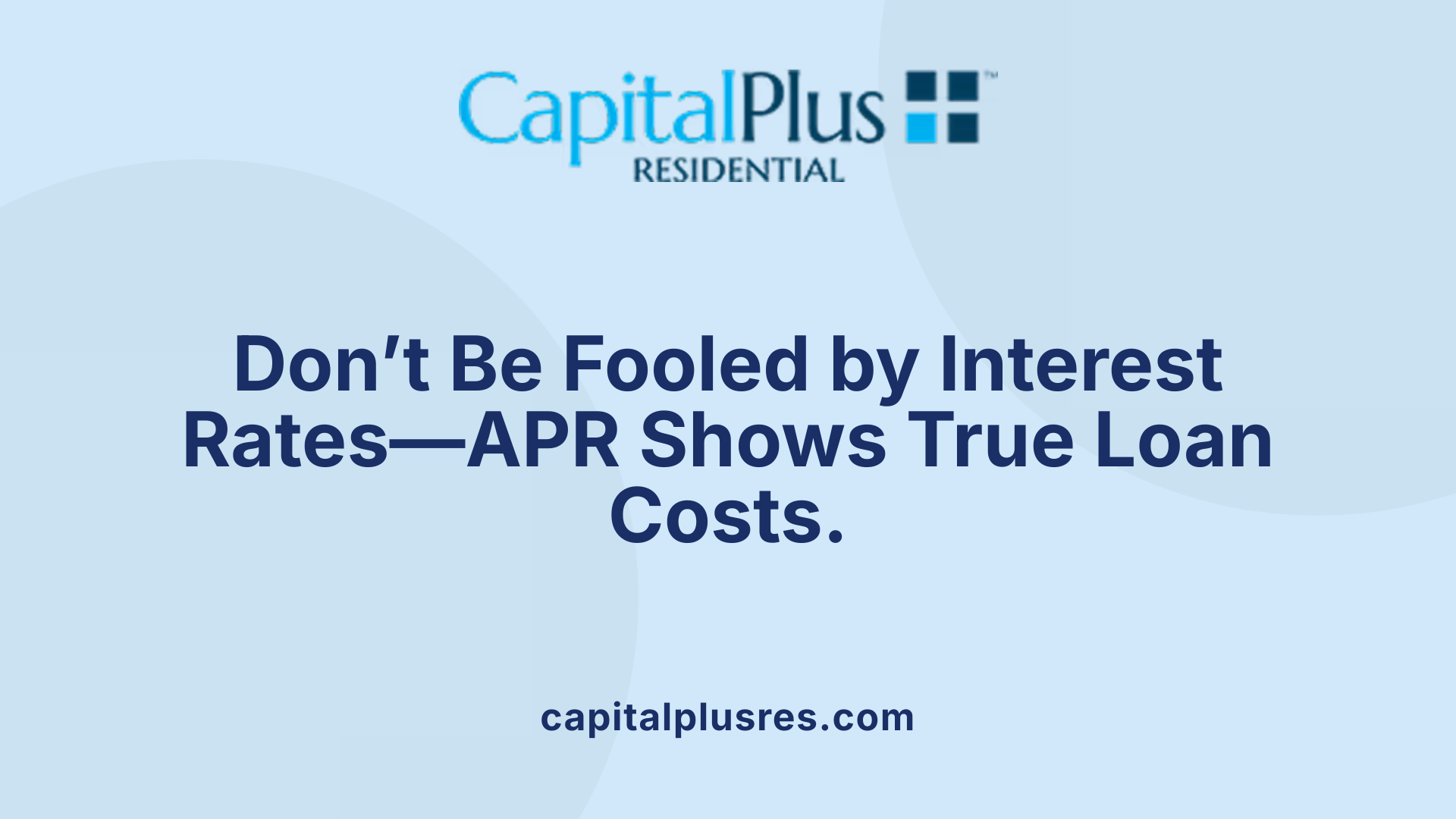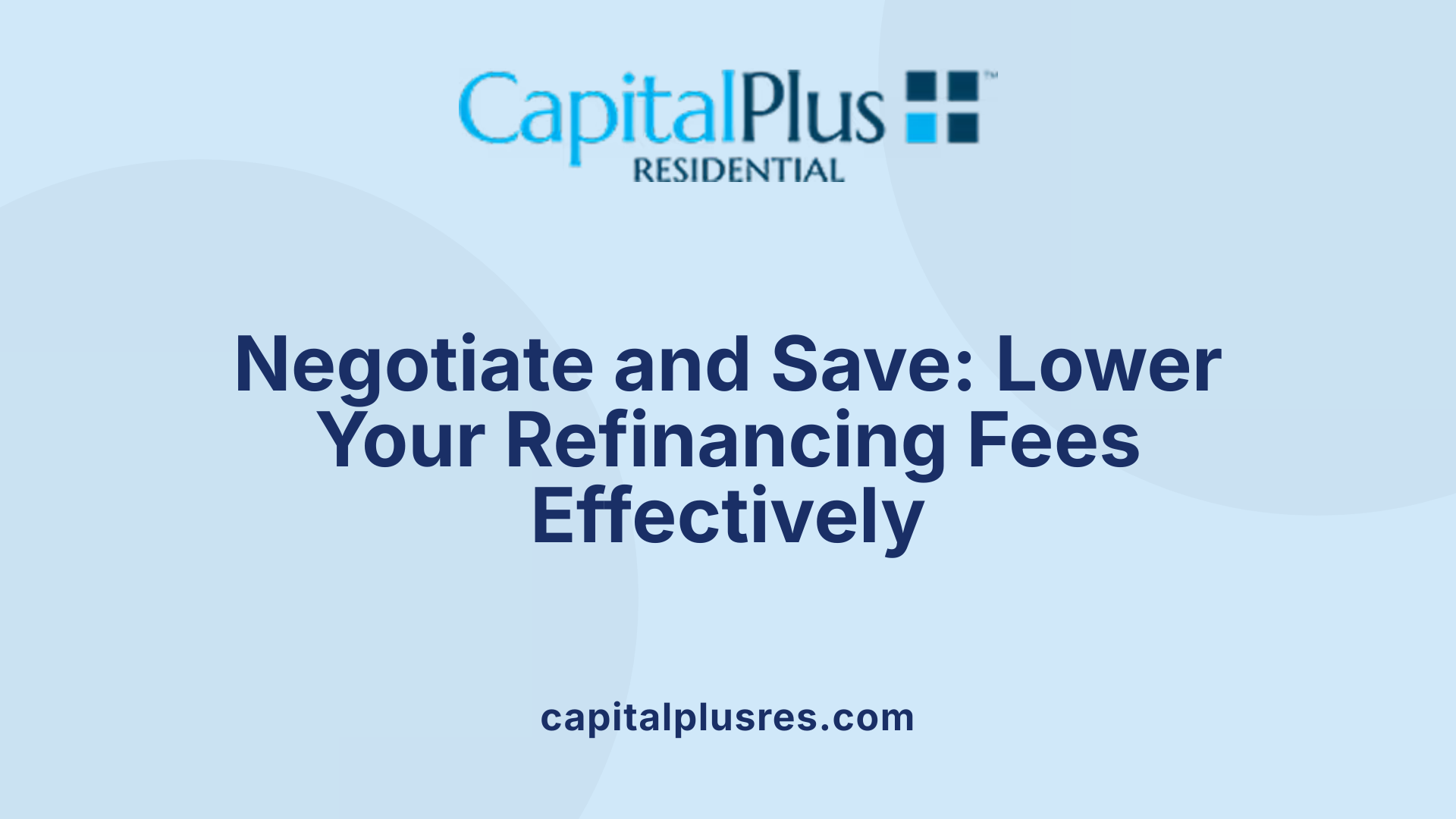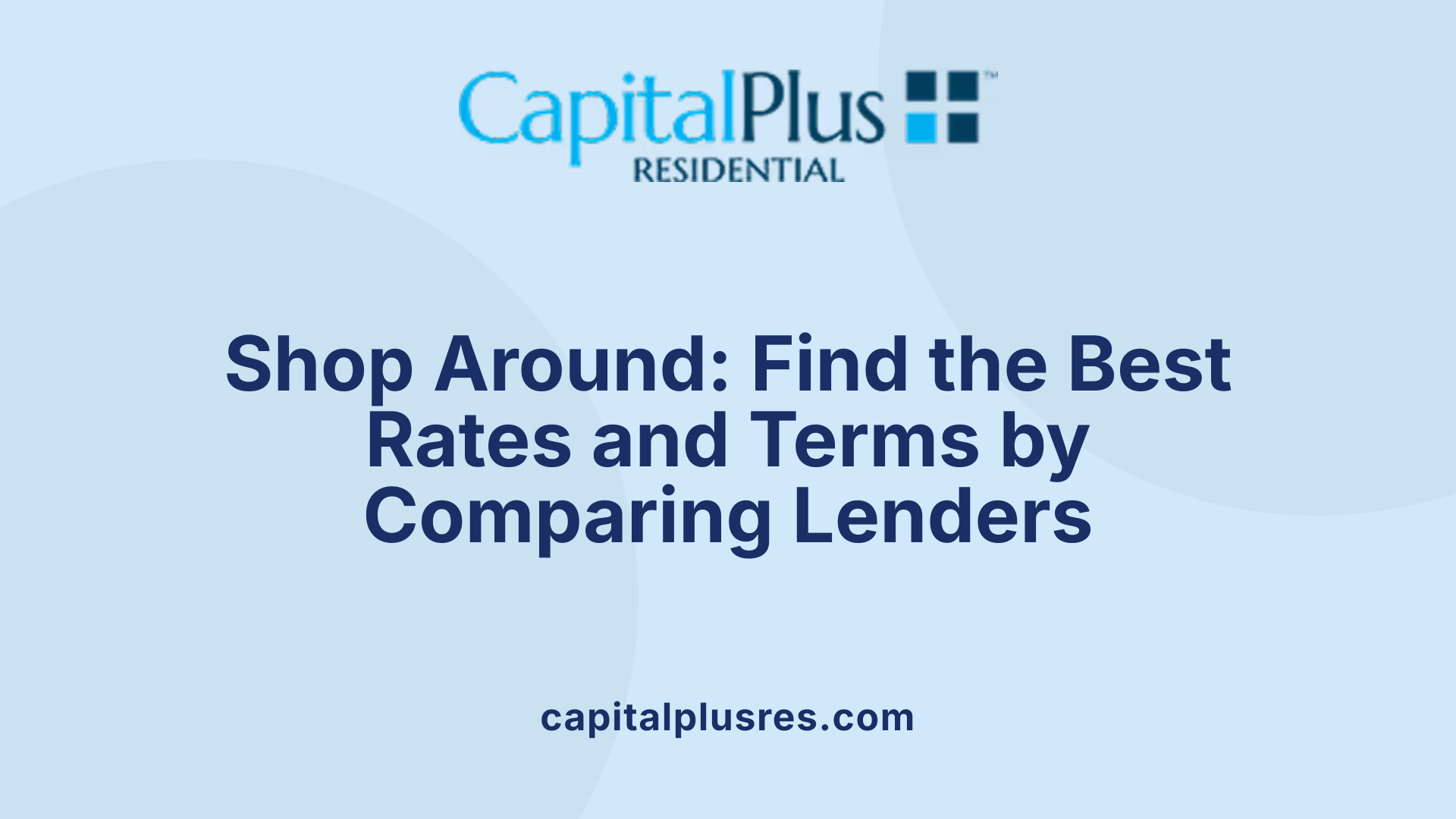Understanding Refinancing Pitfalls Before You Commit
Refinancing your mortgage can be a powerful financial strategy, offering the potential to lower monthly payments, reduce total interest paid, and adjust loan terms. However, it comes with its own set of pitfalls that can undermine these benefits if not carefully navigated. This article explores the common refinancing pitfalls homeowners face and provides expert advice on how to avoid them, ensuring your refinancing experience leads to real savings and financial stability.
Look Beyond the Interest Rate: The Importance of APR

What Is the Difference Between Interest Rate and APR?
When considering refinancing a mortgage, many consumers initially focus on the interest rate. However, the interest rate only reflects the cost of borrowing the principal and does not include additional expenses. The Annual Percentage Rate (APR) provides a broader measure by including lender fees, points paid at closing, and other closing costs. This rate gives a clearer understanding of the total cost of the loan over its term.
Why Does APR Reflect the Total Loan Cost Including Fees and Points?
APR encompasses the interest rate plus various fees and charges associated with the loan. For example, lender fees and points — which are upfront payments to reduce the rate — as well as closing costs like appraisal and inspection fees, are all factored into APR calculations. This approach helps potential borrowers see the complete financial impact, not just the nominal interest expense.
Why Is Focusing Solely on the Interest Rate Misleading?
Focusing only on the interest rate can create an illusion of savings. Two loans might have similar interest rates but substantially different APRs due to varying fees and points. In some cases, opting for a loan with a slightly higher interest rate but lower fees can result in lower overall costs. Conversely, a low interest rate might be tied to high upfront fees, increasing the total expense.
Why Should You Consider APR When Refinancing?
Evaluating the APR provides an accurate comparison between loan offers by incorporating the full range of costs. This clarity enables better decision-making and can avoid surprises after closing. It also helps determine whether refinancing will genuinely save money considering all associated costs.
Table: Interest Rate vs. APR Comparison
| Aspect | Interest Rate | APR |
|---|---|---|
| Includes Fees | No | Yes |
| Includes Points | No | Yes |
| Reflects True Cost | No | Yes |
| Helps Compare Loans | Limited | Comprehensive |
| Impact on Monthly Cost | Directly affects payments | Reflects overall loan cost |
Understanding the difference between interest rate and APR is essential in refinancing decisions. Keeping an eye on APR helps reveal the full financial impact, allowing for smarter choices and better financial outcomes.
Understand and Manage Closing Costs Wisely

Typical closing cost amounts in refinancing
When refinancing your mortgage, closing costs typically average around $4,345. These costs can include application fees, loan origination fees, appraisal charges, inspection fees, insurance premiums, and government fees. Being aware of these expected expenses is crucial to making an informed decision about refinancing.
Consequences of rolling closing costs into mortgage
Not paying closing costs upfront and instead rolling them into your mortgage increases the principal balance of your loan. This results in paying more interest over the life of the loan, which can offset any immediate savings that refinancing might provide. In other words, while this option may reduce out-of-pocket expenses initially, it can lead to higher overall costs in the long term.
Strategies for paying closing costs upfront
Paying closing costs upfront can be a beneficial strategy if you plan on staying in your home for a longer time. It reduces the loan balance and the total interest paid over the loan term. Additionally, negotiating with your lender to reduce discretionary fees can help lower the upfront costs. Shopping around with different lenders can also give you better rates and fee structures for closing costs.
What are the implications of not paying closing costs upfront?
If you roll closing costs into your mortgage principal, it increases your loan balance and results in paying more interest over the life of the loan, potentially offsetting any savings from refinancing. This makes it essential to weigh the immediate cash flow benefits against the long-term financial impact.
Managing closing costs wisely by understanding typical amounts, carefully considering how you pay them, and negotiating fees can make refinancing more cost-effective and financially advantageous.
Negotiate Fees to Lower Your Refinancing Expenses

Can I negotiate lender fees when refinancing?
Yes, you can often negotiate lender fees during the refinancing process. Many of these fees are discretionary, meaning they are not set in stone and lenders have room to adjust them.
Discretionary versus fixed fees
Lender fees can be categorized as fixed or discretionary. Fixed fees are typically set charges that you must pay, such as government recording fees or appraisal costs. Discretionary fees may include application fees, origination fees, or underwriting fees. Since these are flexible, you can try to negotiate a reduction or even waiver.
Tactics for negotiating lender fees
To effectively negotiate fees:
- Shop around and compare fee structures from multiple lenders to strengthen your bargaining position.
- Ask lenders for a breakdown of fees and question any that seem unnecessary or excessive.
- Request that certain fees be reduced or removed, especially if you are a strong candidate with a good credit score.
- Consider offering to pay some fees upfront for a lower interest rate, which may save money overall.
Potential savings from fee negotiation
Negotiating lender fees can lead to substantial savings. Since refinancing closing costs typically range from 3% to 6% of the loan amount, reducing discretionary fees can lower your out-of-pocket expenses or reduce the fees rolled into your loan principal. This, in turn, decreases the total interest you pay over the life of your mortgage.
Being proactive and informed when negotiating lender fees enhances the financial benefits of refinancing and helps ensure you get the best deal possible.
Shop Around: Comparing Lenders is Essential

Why should I shop around among different lenders before refinancing?
Mortgage rates and fees vary significantly between lenders, which makes shopping around a crucial step before refinancing. By comparing different offers, borrowers can uncover better interest rates and more favorable loan terms, potentially saving thousands of dollars over the life of their mortgage.
Benefits of comparing loan rates and terms
Exploring various lenders provides not only a comparison of interest rates but also an understanding of associated fees, closing costs, and loan conditions. These factors all contribute to the true cost of refinancing and influence monthly payments and long-term financial impact. Learning the full picture helps homeowners avoid surprises and make informed decisions aligned with their financial goals.
Variability of mortgage rates among lenders
Mortgage rates are rarely uniform; they fluctuate between lenders because each lender has different overheads, risk assessments, and profit margins. This variability provides an opportunity to find a deal that better fits individual circumstances, such as loan amount, credit score, and property value.
Using good faith estimates to compare offers
Consumers should request and review good faith estimates from multiple lenders. These documents disclose the fees and estimated costs associated with the loan, allowing an apples-to-apples comparison between offers. Analyzing these estimates can reveal hidden or discretionary fees that might be negotiable, leading to further savings.
Comparing lenders thoroughly and using good faith estimates empowers homeowners to negotiate better deals and choose loans that meet both their immediate needs and long-term financial strategies.
Beware of Home Equity Changes and Market Risks
How can refinancing affect my home equity?
Refinancing your mortgage can directly impact your home equity, which is the portion of your home’s value that you truly own without debt. When you refinance, especially if you roll closing costs or fees into the loan, your principal balance increases, thereby reducing your home equity.
What are the risks during economic downturns and declining home values?
Economic downturns or a drop in housing market values can aggravate the effects of refinancing on your equity. If the value of your home falls below the amount you owe after refinancing, you become "underwater" on your mortgage.
This situation means you owe more than your home is currently worth, which limits your options:
- Difficulties in refinancing again to better terms
- Challenges in selling your home without incurring losses
- Reduced ability to use home equity for loans or cash-out refinancing
What are the consequences of being underwater on a mortgage?
Being underwater can significantly restrict financial flexibility. Homeowners may struggle to qualify for additional credit or refinance opportunities. Moreover, if forced to sell, they might face financial losses.
Therefore, it’s crucial to carefully consider how refinancing affects your home equity, especially during uncertain market conditions. Understanding these risks can help you make informed decisions and avoid potential financial pitfalls.
Evaluating Buying Points to Reduce Interest Costs
What does it mean to buy points at closing?
Buying points, also known as paying discount points, involves making an upfront payment at closing to lower your mortgage interest rate. Each point typically costs 1% of the loan amount and reduces the interest rate by a small fraction, which can lead to significant savings over the life of the loan.
Upfront investment versus long-term savings
While paying for points requires a higher initial investment, this payment can reduce monthly mortgage charges and total interest paid over time. However, rolling these costs into the loan instead of paying upfront increases your principal and interest expenses. Calculating the break-even period—the time needed for monthly savings to cover the upfront cost—is essential before deciding.
Who benefits from buying points?
This strategy favors homeowners who plan to stay in their home and maintain the mortgage for an extended period. Those planning to move or refinance again soon might not recoup their upfront investment. Buying points offers more advantage with longer loan terms, especially for those switching from adjustable to fixed rates or shortening loan durations.
Is buying points when refinancing always a good idea? Buying points lowers your interest rate and total interest paid but requires an upfront cost. It is most beneficial for homeowners planning to keep the loan long-term to recoup the initial expense.
Benefits and Trade-offs of Shorter-Term Refinancing
What should I consider when refinancing into a shorter-term loan?
Refinancing from a 30-year mortgage to a 15-year loan can offer several financial advantages, but it's important to weigh the trade-offs carefully. A shorter-term loan generally comes with a lower interest rate, which reduces the total interest paid over the life of the loan. This means you can pay off your mortgage faster and build home equity more quickly, ultimately saving thousands of dollars.
However, the monthly payments for a 15-year loan are significantly higher than for a 30-year loan. Homeowners must have the financial capacity to manage these increased payments comfortably to avoid financial strain. While accelerated debt payoff is attractive, affordability should remain a top priority to prevent default or financial stress.
Choosing a shorter-term refinance suits homeowners planning to stay in their homes long-term and who want to reduce overall interest costs. It's less suitable for those with tighter monthly budgets or plans to move soon, as the upfront payment increase could outweigh the benefits.
In summary, refinancing into a shorter-term loan offers benefits like lower interest rates and faster equity growth, but requires careful evaluation of your budget to balance higher monthly payments with long-term savings.
The Stability of Fixed-Rate versus Adjustable-Rate Mortgages
Advantages of switching from ARM to fixed-rate
Switching from an adjustable-rate mortgage (ARM) to a fixed-rate mortgage offers significant benefits. The primary advantage is payment stability. With a fixed-rate mortgage, homeowners lock in a consistent interest rate for the life of the loan, which helps in budgeting monthly expenses without surprises. Refinancing from an ARM removes the uncertainty associated with fluctuating rates, especially during economic changes.
Risks of payment volatility with ARMs
ARMs come with the risk of payment volatility because their interest rates can adjust periodically based on market conditions. This means that monthly mortgage payments can increase unexpectedly, posing financial strain. Such unpredictability can be difficult to manage, particularly if a borrower’s income is fixed or tight.
Refinancing to better ARM terms
For some homeowners, refinancing can still improve their ARM by securing better terms, such as smaller adjustment rates or lower caps on how much interest rates can increase. This can mitigate some payment volatility while maintaining lower initial rates compared to fixed mortgages.
Why might switching from an adjustable-rate to a fixed-rate mortgage be beneficial?
Refinancing to a fixed-rate mortgage provides protection against rising interest rates and eliminates the risk of payment spikes. This transition creates predictable budgeting and financial stability, which is often desirable for long-term homeowners. While ARMs may initially offer lower payments, a fixed-rate loan offers peace of mind through consistent costs.
This decision should align with personal financial goals and consider how long the homeowner plans to stay in their home, as well as the current interest rate environment.
Cash-Out Refinancing: Uses and Risks
What should I know about cash-out refinancing?
Cash-out refinancing is a way for homeowners to tap into their home's equity by replacing their current mortgage with a larger loan and receiving the difference in cash. This can provide funds for home improvements, debt consolidation, or other financial needs. However, it's important to understand that this increases your total debt and reduces your ownership stake in the property.
While the extra cash can be beneficial, cash-out refinancing also raises your loan balance and monthly payments. It increases financial risk, especially if home values decline or economic conditions worsen, potentially leaving you owing more than your home is worth.
When is cash-out refinancing appropriate?
Cash-out refinancing may be suitable when you need significant funds for important expenses and have stable income, good credit, and sufficient home equity. It’s crucial to consider long-term financial goals and avoid overleveraging your home. Consulting with a trustworthy mortgage broker or financial advisor can help ensure that the added debt doesn't jeopardize your financial security.
Weighing the impact on ownership and debt levels
By increasing your mortgage debt, cash-out refinancing decreases your immediate home equity and can affect your ability to refinance again or sell your home if market values drop. It's recommended to carefully evaluate the costs, fees, and your repayment capability before proceeding.
Understanding all associated risks and benefits can help you decide whether cash-out refinancing fits your financial situation and goals.
When Refinancing May Not Be Advisable
Are there situations when refinancing is not a good idea?
Yes, refinancing isn't always the optimal choice. One important factor is the remaining term on your current mortgage. If you have a long time left to pay off your existing loan, the upfront costs of refinancing—such as closing costs and lender fees—might not be recouped by the monthly savings from a lower interest rate.
Long remaining mortgage term issues
When a mortgage has many years left, refinancing costs can take a considerable time to break even. This scenario means you might spend several years paying more in fees before actually benefiting financially. It's essential to calculate the break-even period before deciding.
Prepayment penalties
Some mortgages include prepayment penalties for paying off your loan early. These penalties can add thousands of dollars to the cost of refinancing, making it potentially more expensive than keeping the current mortgage.
Planning to move soon
If you plan to sell your home or move in the near future, refinancing generally isn't advisable. The costs involved typically require several years to recover. Moving shortly after refinancing means you may never recoup those expenses.
Carefully evaluating these factors—long mortgage terms, prepayment penalties, and your personal plans to stay in the home—helps avoid refinancing that could lead to financial loss rather than savings.
Eligibility Factors and Credit Considerations
What eligibility criteria affect refinancing approval?
Refinancing a mortgage isn't automatic; lenders evaluate several eligibility criteria before approving a new loan. Important factors include your income, credit score, the current value of your home, and the loan-to-value (LTV) ratio.
Your income must be stable enough to support the new loan payments. Lenders assess your ability to repay based on earnings and employment history. A strong credit score improves your chances and helps secure better interest rates.
The home's value also plays a vital role. If the market value has declined since you purchased, or if your loan balance is close to or exceeds your home's worth (an issue called being "underwater"), refinancing becomes more challenging.
Loan-to-value ratio measures how much you owe compared to your home's appraised value. A high LTV usually means higher risk for lenders, which often results in stricter qualification standards or higher interest rates.
Maintaining good credit health is critical during refinancing. Activities like opening new credit lines, making large purchases, or missing payments can lower your credit score and reduce your approval odds.
Being careful during the refinancing process—such as avoiding job changes or delayed payments—helps prevent unexpected denials. Understanding these eligibility requirements and protecting your credit can make refinancing smoother and increase your chances for better loan terms.
Calculate Your Break-Even Period Before Committing
What is the break-even period?
The break-even period in refinancing refers to the amount of time it takes to recover the upfront refinancing costs through the savings gained from a lower monthly mortgage payment. Essentially, it tells you when the refinancing investment starts to pay off.
How to calculate break-even point
To calculate this period, you divide the total refinancing costs by the monthly savings on your mortgage payments. For example, if your refinancing costs are $4,000 and your monthly saving is $200, the break-even period would be 20 months. This means after 20 months, you start to benefit financially from the refinance.
Using break-even analysis in refinancing decisions
Understanding your break-even period is crucial because it helps you decide if refinancing makes financial sense based on how long you plan to stay in your home. If you plan to move or refinance again before reaching this period, the refinancing may not be cost-effective. Always consider this alongside other factors like loan terms, APR, and your long-term financial goals to make a well-rounded decision.
Why is calculating the break-even period important? The break-even period shows how long it takes to recover refinancing costs through monthly savings. If you plan to stay in your home beyond this time, refinancing is more likely to be financially advantageous.
Importance of Transparency with Your Mortgage Broker
Sharing accurate financial details
Being transparent with your mortgage broker means providing complete and honest information about your financial status. This includes your income, debts, employment history, and credit situation. Sharing these details upfront helps the broker accurately assess your refinancing options and prepare your application correctly.
Preventing application delays and rejections
When you are transparent, you minimize the risk of unforeseen issues during underwriting. Incomplete or inaccurate information can cause delays or even lead to loan denial. Brokers depend on the accuracy of your financial disclosures to avoid surprises that might jeopardize the refinancing process.
Choosing a trustworthy mortgage broker
Selecting a broker who demonstrates integrity and transparency is crucial. A trustworthy mortgage broker guides you through the complex refinancing journey with clear communication, ensuring you understand fees, rates, and loan terms. This transparency fosters confidence and can lead to better loan outcomes.
How does being transparent with your mortgage broker help?
Honest disclosure of financial details prevents delays or loan rejections. Selecting a broker known for integrity and transparency ensures a smoother refinancing process. This approach protects your refinancing experience from unexpected setbacks and improves your chance of securing favorable loan terms.
Avoid Actions That Jeopardize Your Loan Application
Why Is Job Stability Important During Refinancing?
Maintaining a stable job is crucial when applying for refinancing. Lenders view consistent employment as a sign of reliable income and financial stability. Quitting your job or changing employment without securing new income can raise red flags, making lenders hesitant to approve your application. This may delay the process or lead to outright rejection.
What Risks Do Quitting Jobs or Late Payments Pose?
Taking actions like quitting your job or making late payments during the refinancing process can severely damage your chances. These activities often lower your credit score and signal increased risk to lenders. Even seemingly small missteps, such as missing a single payment, can prompt lenders to rethink your application because it affects your perceived ability to repay the loan.
How Can I Maintain My Credit Score Before Refinancing?
To secure the best refinancing terms, protect your credit score by avoiding new credit inquiries or large purchases that could increase your debt-to-income ratio. Keep paying bills on time, minimize credit card balances, and refrain from opening new credit lines during the application period. This proactive approach helps ensure your credit profile remains strong, improving your chances for approval and favorable rates.
| Potential Risk | Effect on Application | Recommended Action |
|---|---|---|
| Quitting job | Signals income instability, leading to delays | Maintain employment until refinance completion |
| Late or missed payments | Lowers credit score, signals financial distress | Make all payments on time |
| Opening new credit lines | Causes multiple credit inquiries, lowers score | Avoid applying for new credit |
Safeguarding your financial profile during refinancing is essential to avoid setbacks and secure the best mortgage terms possible.
Utilize Resources and Expert Advice for Informed Decisions
How can I make an informed refinancing decision?
Making an educated refinancing choice involves leveraging several valuable resources and expert perspectives. First, using online calculators enables you to simulate different scenarios, helping you gauge true costs, monthly payments, and potential savings. These tools factor in interest rates, loan terms, and fees to offer a personalized financial outlook.
Consulting financial advisors and current lenders
Financial advisors provide tailored guidance based on your overall financial situation and long-term goals. They assist in balancing refinancing benefits against possible risks, such as changing loan terms or impact on home equity. Additionally, discussing your options with your current lender can reveal competitive rates or flexible terms that might not be widely advertised.
Avoiding marketing pitfalls in refinancing
Refinancing advertisements can sometimes emphasize attractive interest rates without revealing hidden fees or terms. Being skeptical of "no-cost" refinancing offers is crucial, as these often involve higher rates or rolled-in fees that raise the total cost over time. Always ask for detailed good faith estimates and read the fine print.
By combining online tools, expert counsel, and direct lender communication, you can better understand the true costs and benefits of refinancing. This approach helps you avoid common traps and select a mortgage option best suited to your financial future.
Navigating Refinancing Pitfalls for Financial Success
Refinancing your mortgage is a significant financial decision that demands careful evaluation of costs, benefits, and personal circumstances. By looking beyond simple interest rates to consider APR, managing and negotiating fees, shopping around, and understanding loan terms, homeowners can avoid common pitfalls. Maintaining good credit, selecting trustworthy brokers, and timing the refinance appropriately are also essential steps. With diligence and informed planning, refinancing can unlock savings, stability, and financial flexibility, helping you achieve your long-term goals without unexpected setbacks.
References
Latest Blog


Get Pre-Approved Today
Start your secure online application now so you can get pre-approved for a mortgage (and close on your dream home) quickly within 5 minutes.









